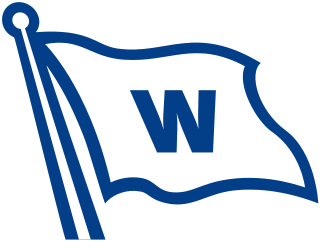
A buoy is a floating device that can have many purposes. It can be anchored (stationary) or allowed to drift with ocean currents.
The International Association of Marine Aids to Navigation and Lighthouse Authorities (IALA), previously known as International Association of Lighthouse Authorities, is an intergovernmental organization founded in 1957 to collect and provide nautical expertise and advice. IALA is also known by its French name of Association Internationale de Signalisation Maritime (AISM).

MV Derbyshire was a British ore-bulk-oil combination carrier built in 1976 by Swan Hunter, as the last in the series of the Bridge-class sextet. She was registered at Liverpool and owned by Bibby Line.

A navigational aid (NAVAID), also known as aid to navigation (ATON), is any sort of signal, markers or guidance equipment which aids the traveler in navigation, usually nautical or aviation travel. Common types of such aids include lighthouses, buoys, fog signals, and day beacons.

Wallenius Wilhelmsen Logistics was a privately owned Norwegian/Swedish shipping company, established in 1999 and co-owned by the two shipping companies Wallenius Lines and Wilh. Wilhelmsen.

Wilh. Wilhelmsen Holding ASA (WWH) is a Norwegian multinational maritime group, headquartered in Lysaker, Norway. The group employs more than 21,000 people and has operations in 75 nations. The Wilhelmsen group operates the largest maritime network in the world, with over 2200 locations worldwide.

MV Taiko was a roll-on/roll-off (RoRo) freighter managed by the Norwegian-Swedish shipping line Wallenius Wilhelmsen Logistics. She was built as Barber Hector by Hyundai Heavy Industries at Ulsan, South Korea in 1984 for Blue Funnel Line, part of the Liverpool company Ocean Transport & Trading Ltd, and was Blue Funnel's last newbuilding. She was deployed on Barber Blue Sea Line, a joint venture between Blue Funnel, Wilh. Wilhelmsen, Oslo and the Broström Group of Sweden. In 1988 Ocean withdrew from Barber Blue Sea line and Barber Hector was sold to the Swedish partner, chartered to Wilhelmsen and renamed Taiko. Wilhelmsen purchased the vessel in 1993.
Combinatie Berging Tricolor (CBT) was a consortium of -mainly- Dutch salvaging companies led by Smit Salvaging BV, a daughter company of Smit International.

MV Baltic Ace was a Bahamian-flagged car carrier, that sank in the North Sea on 5 December 2012 after a collision with the Cyprus-registered container ship Corvus J. Built by Stocznia Gdynia in Poland, the ship had been in service since 2007.

SS Oceana was a P&O passenger liner and cargo vessel, launched in 1887 by Harland and Wolff of Belfast and completed in 1888. Originally assigned to carry passengers and mail between London and Australia, she was later assigned to routes between London and British India. On 16 March 1912 the ship collided in the Strait of Dover with the Pisagua, a 2,850 GRT German-registered four-masted steel-hulled barque. As a result Oceana sank off Beachy Head on the East Sussex coast, with the loss of 17 lives.
Asian Hercules II is a floating sheerleg crane vessel owned and operated by Asian Lift.

An Emergency wreck buoy is used to warn of a new wreck which has not yet been listed in maritime documents. The buoy is expected to be deployed for the first 24-72 hours after the wreck occurs. After that time more permanent buoyage should be deployed and charts updated.

EUKOR is a specialised Roll-on/roll-off shipping line formed in 2002. The company's main business is the sea carriage of new and used cars and High & Heavy cargo.
The following index is provided as an overview of and topical guide to Wikipedia's articles on recreational dive sites. The level of coverage may vary:

MV Thorco Cloud was a general cargo ship owned by Thorco Projects that sank in the Singapore Strait in December 2015 after a collision with the chemical tanker MV Stolt Commitment. The collision resulted in six casualties from a total crew of 12. The collision caused the ship to split into two parts, which sank approximately 1.85 kilometres (1.15 mi) apart at a depth of 70 metres (230 ft) in the traffic separation scheme of the Singapore Strait, one of the world's busiest shipping lanes. The wreck was removed in 2019.










